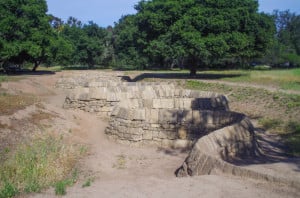In a small clearing near the Cantor Arts Center sits a winding stone sculpture. The spine-like structure, called “Stone River,” was crafted by British sculptor Andy Goldsworthy in 2001 and is made out of stacked broken sandstone from the 1906 and 1989 earthquakes.
This sculpture is just one of many that make up the University’s distinguished and vibrant outdoor art collection. There are nearly 150 different pieces in the collection, which spans over 100 years and includes modern, contemporary, abstract and figurative works. Some of the earliest works, like Antonio Frilli’s “Faith and Menander,” were on campus at the same time as Leland and Jane Stanford.

Connie Wolf ’81, the museum director at Cantor, spoke to the importance of having outdoor art on campus.
“I think that art needs to permeate our lives in as many ways as it can…we need to make sure that art is extended as far as possible on campus and meets people where they are,” Wolf said.
To that end, Cantor has sought to disperse the many pieces across diverse areas of campus – from the Stanford Equestrian Center parking lot to the Stanford Arboretum.
One of the most notable outdoor art attractions is Cantor’s impressive collection of Auguste Rodin’s bronze sculptures, located to the right of the museum in the Rodin Sculpture Garden and at Memorial Court.
While some pieces make it to campus as generous gifts from donors, others are purchased or commissioned with funds raised by Cantor. Wolf noted that every piece is carefully chosen by the Outdoor Art Panel, which is comprised of faculty, staff, volunteers and students.
Their tastes are selective – in the past the museum has refused donated art because it did not meet museum standards.
“We are looking for a certain level of excellence and works that we think that will be meaningful to students and that are important works of art,” Wolf said. “A work that is important to students is one that is something that you can enjoy, something that makes you think, something that creates a kind of oasis to experience, something…that challenges you a little bit.”
The most recent additions to the collection include “Miwok” by Mark Di Suvero, located at the Stanford Medical School on the Dean’s Lawn, “The Three Graces” by Charles Ginnever at the Oval, “Bedford Sentinels” by Beverly Pepper next to the Landau Economics Building, and Goldsworthy’s “Stone River.”
While the collection will continue to receive new additions, there is no plan to let go of any of the older pieces.
“We’re never getting rid of any of them,” Wolf said. “These are works that are in our collection, and you just don’t get rid of any of them. You take care of them.”
A staff made up of paid student technicians maintains the pieces. The technicians are trained by a professional conservator to effectively wash, wax and remove any potential graffiti from the sculptures, according to Susan Roberts-Manganelli, manager of collections, exhibitions and conservation at the Cantor. All of the works are cleaned on a 60- or 90-day rotation.
While pieces are sometimes moved – Mark di Suvero’s “The Sieve of Eratosthenes” was recently relocated to a vacant grassy patch outside of Stern Hall due to construction at its primary location – the curators emphasized that the museum tries to avoid it whenever possible.
Moving a large outdoor piece can be complicated and expensive, totaling anywhere from $25,000 to $150,000. Identifying the spot for relocation requires a team of architects and curators to take into account everything from irrigation and surrounding vegetation, as sap from overhanging trees can be harmful to the works.
While the outdoor pieces may vary greatly in form, they all share the defining quality of interactivity. At the di Suvero sculpture outside of Stern, on any given day, students congregate under, around, and even on top of the red structure (although Wolf was quick to note that sitting on the sculpture is not allowed.) Elementary schools often make visits to the Rodin sculpture garden, running around and eating lunch at the feet of the late 19th century bronze figures.
“All of the sculptures on campus are available to view at all hours, seven days a week.” Wolf said. “We want people to experience it whenever they want to. Art on campus is for everybody.”
Contact Josie Hodson at jhodson ‘at’ Stanford ‘dot’ edu.
